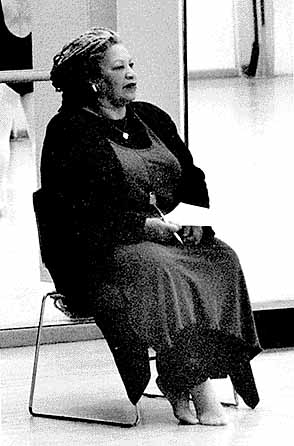From the Princeton Weekly Bulletin, March 9, 1998
Princeton Atelier brings choreographer Martine van Hamel to campus
Like a fantasy class
By Sally Freedman
This is like a fantasy class for me," says Deborah Way '98. "American Ballet Theatre was one of the companies I dreamed of working with when I considered dancing as a career."
Now an economics major, Way has a job waiting for her on Wall Street when she graduates, but this semester she is participating in the Princeton Atelier offered in collaboration with American Ballet Theatre (ABT). This innovative course involves not only lectures and seminars but also a strong studio component: a three-week ballet workshop with choreographer Martine van Hamel and members of the ABT Studio Company.
The Princeton Atelier program was created by Toni Morrison, Robert F. Goheen Professor in the Humanities.
As she describes it, the program "brings professional artists to the University for intensive, in-residence collaborative projects with students and faculty. Artists who lead an Atelier seminar select a project that they want to watch unfold, examine or experiment with -- in the company of students -- before developing it for the professional art world."
|
|
|
|
|
|
25 hours of ballet a week
Katherine Johnson '99, who has been taking 25 hours of class a week at Princeton Ballet on top of her schoolwork, was one of 40 students who auditioned with van Hamel for the Ballet Atelier last fall. "When the cast list was posted," she recalls, "my name wasn't on it; but ABT called a couple of days later to say I had been left out by mistake -- I was in!"
Though many students learned about the Atelier from the regular Course Offerings booklet, Johnson heard about it from Ze'eva Cohen, professor in the humanities, coordinator of dance in the Program in Theater and Dance. "This Atelier is a wonderful opportunity," says Cohen, "especially for ballet students, who otherwise have little outlet for their talents at Princeton, where the dance program is necessarily geared toward a wider range of student abilities and training."
In addition to the studio intensive, the Ballet Atelier has included several seminars--one on the Atelier program and process, led by Morrison; and another on choreography, led by Cohen, whose own dance experience spans 40 years, both as performer and choreographer. A third will be on dance writing, led by critic Terry Teachout.
A series of panel discussions has given both students and the general public a chance to hear members of ABT and other dance companies talk about their real-life involvement in the professional dance world. Topics covered in February included dance management and history, choreography and the life of a dancer. Future panel discussions will cover "The Dance Critic" on April 6 and "Design of Dance" on April 14.
Students' experiences mirrored
The students heard their own experiences mirrored in those of the panelists.
Like ABT dancer Kevin MacKenzie, who grew up in Burlington, Vt., Princeton student Way quickly outgrew the local resources of her home town of Laramie, Wyo., and had to go away to continue training. MacKenzie went to the National Academy of Ballet in Washington, D.C., and on to the Joffrey Ballet, then ABT, where he was a principal dancer and is now artistic director. Way tried Interlaken Arts Academy in Michigan as a high school freshman, and "I loved the dancing, but I got too homesick," she says. She went back to Laramie and did her advanced ballet training in summer programs at the San Francisco Ballet School. She gave up the idea of becoming a professional dancer when she chose to come to Princeton, she says, but she may want to work eventually in arts administration.
Like ballerina Kathleen Moore, who described how she spent her teens vowing to give up ballet after just one more recital, English major Johnson says, "I never wanted to be a dancer when I was younger--but I can't imagine stopping, either." Moore went on to join ABT and rise through the ranks as a corps de ballet dancer, soloist and now principal. What Johnson will do, she doesn't know. "Even saying you want to be a professional dancer is very frightening," she feels.
For the moment, Johnson is simply reveling in the opportunity "to learn about and work with these amazing performers and personalities. It's something I never expected. I'm just ecstatic."
Support from alumnus
Two other Ateliers are being offered this semester in addition to the collaboration with American Ballet Theatre: one on The Architecture of the Narrative with Morrison; and another on Performance and Writing, with Joyce Carol Oates, Berlind Professor in the Humanities, and director Susan Tubert.
Major support for the Atelier program has been provided by Peter Joseph, Class of 1972, who has established an ongoing endowment for the program, as well as supporting this semester's Atelier with ABT.
"When I met Toni Morrison," Joseph says, "I thought it was extraordinary that she could bring this caliber of professional artists to campus. An experience like this as a student could be a major event in a person's life."
Joseph chairs the board of ABT, and one of his hopes for the current Atelier is that "it will stimulate some outstanding new choreography for the company and also stimulate in Princeton and the wider community a deeper appreciation of dance."
"The creation of the Atelier seminars has been an important project for me personally," Morrison says, "for it assumes not only that art is central to a liberal arts education, but that artistic creation is necessary to intellectual life, and critical to the survival and health of the community that nurtures it."
